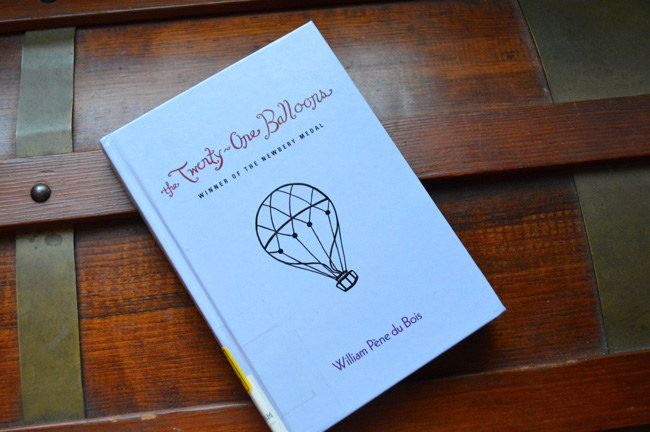William Pène du Bois’s 1948 Newbery winning book The Twenty-One Balloons tells the story of a math teacher – turned amateur balloonist who ends up stranded on the supposedly uninhabited Pacific island of Krakatoa right before its fated (and real-life) volcanic eruption in 1883. The majority of the book takes place on (and the attempt to get off) the island which also happens to have an almost limitless supply of diamonds and two dozen families who live in extraordinary wealth there in a sort of tiny utopian society. Our main character, Professor William Waterman Sherman, spends most of the book being the reader’s eyes to the tiny balloon sleeping quarters and the elaborate mansions of Krakatoa, before (spoiler alert) he and the other families escape using 20 balloons.
What I liked. I loved the description of the buildings. Professor Sherman’s first balloon is the 1948 equivalent of contemporary 100 square foot tiny houses. Everything in that balloon is light and dual purpose with pulleys, and nothing is superfluous. And then each family has its own house (and restaurant) made in various styles (French Chateaus, or Moroccan Palace)—many complete with Jetson-like inventions to make cooking and cleaning a breeze.
What was interesting. I thought that the ability to take a real historical event — like the very large volcanic explosion of Krakatoa— and weave it into a fantastical utopian society was so cool. It reminded me a bit of folk tales explaining how a spider came to have eight legs. I love the flexibility of historical fiction to be able to on the one hand weave a tale using as many facts and details as are available to create something as plausible and realistic as possible, and on the other hand take just a few key dates and spin a fantasy out of them.
What were some limitations. Overall I think it was a really strong little book, short and sweet, with fun ideas and beautiful illustrations by the author. Sometimes I think it would have been cool to get to know some of the families on the island a bit better (you know like a female character…), but there really wasn’t a lot of space for that. Sometimes, too, the various houses (American, British, Chinese, Dutch) might be seen as not the most culturally sensitive or accurate. Both of these are standard criticisms of very early Newberies.
Why I think it’s a Newbery. The Twenty-One Balloons is just a solid kids adventure story, fun and whimsical, but with enough of a utopian slant to raise some good questions about what it means to be happy, to have enough money, to work together, and find meaning in your day to day living.
Similarity to other Newbery winners. This book reminded me a lot of The Voyages of Dr. Doolittle, with travel and funny global adventures. Many of the more recent Newberies have been more local in scope (and mostly I think that has helped them be stronger stories) but it’s fun to have one that’s pure fancy.
What it teaches me as a writer. Setting, setting, setting! This book had setting in spades, the most wonderful intricate details of space, and I wanted to ride in the balloons or dine in the Krakatoa mansions, or daydream about what a limitless amount of money on a beautiful desert island could build me.
Have you read The Twenty-One Balloons? What are your favorite travel-adventure books?
*Note* This post contains Amazon affiliate links, which means if you were to buy a book, I’d get a tiny commission at no cost to you. Thanks for supporting Stories & Thyme!*








